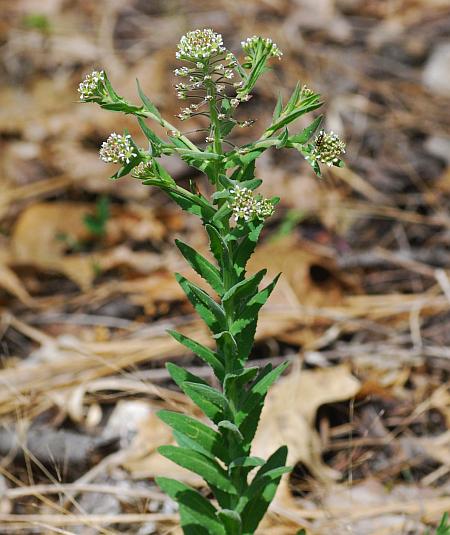Lepidium campestre (L.) W.T. Aiton
Field Cress

Introduced
CC = *
CW = 5
MOC = 64
© SRTurner
Lepidium campestre (L.) W.T. AitonField Cress | |
 |
Introduced CC = * CW = 5 MOC = 64 |
© SRTurner |
|
Family - Brassicaceae Habit - Taprooted annual forb. Stems - Erect, to 50 cm, usually unbranched below the inflorescence, sometimes multiple from base, densely pubescent with short, spreading hairs.
Leaves - Alternate, 2-7 cm long, sessile, clasping the stem with pointed auricles, dense along stem, the blades narrowly oblong to lanceolate in outline, the margins usually shallowly toothed (the basal leaves less commonly 1 time pinnately lobed), densely short-hairy. Basal leaves petiolate, entire or with shallow lobes.
Inflorescence - Compact terminal panicles or racemes, ebracteate, elongating in fruit to 25 cm. Axis and pedicels hairy. Pedicels to 8 mm long in fruit, spreading.
Flowers - Sepals 4, 1.3-1.8 mm long, narrowly elliptic. Petals 4, 1.8-2.5 mm long, spatulate, clawed, white. Stamens 6. Styles 0.1-0.5 mm long, persistent in fruit. Ovary compressed.
Fruits - Silicles 5-6 mm long, ovate to broadly oblong in outline, the tip shallowly notched and relatively broadly winged, flattened, the valves with minute papillae. Seeds 2.0-2.3 mm long, 1 per locule, obovate in outline, not winged, the surface minutely papillate, reddish gray to dark brown or black.
Flowering - April - June. Habitat - Pastures, fields, roadsides, railroads, open disturbed areas. Origin - Native to Europe. Lookalikes - Thlaspi arvense, other species of Lepidium. Other info. - This plant is often overlooked or ignored due to its small flowers and generally weedy appearance. It is common across most of Missouri, and is also found in many other areas of the continental U.S. It is easily recognized by the hairy stems with numerous clasping leaves, tiny white flowers in dense inflorescences, and small disklike fruits. The inflorescences are often branched and assume a rough candelabra shape. The plant tends to be canescent - having a greyish cast due to a dense covering of short hairs. The fruits have only 1 seed per locule (2 per fruit). Photographs taken at Weldon Spring Conservation Area, St. Charles County, MO, 5-10-2009, 4-13-2011, and 4-6-2012, Greensfelder Park, near Pacific, St. Louis County, MO, 4-20-2010, and along the Katy Trail near Dutzow, Warren County, MO, 4-22-2020 (SRTurner). |